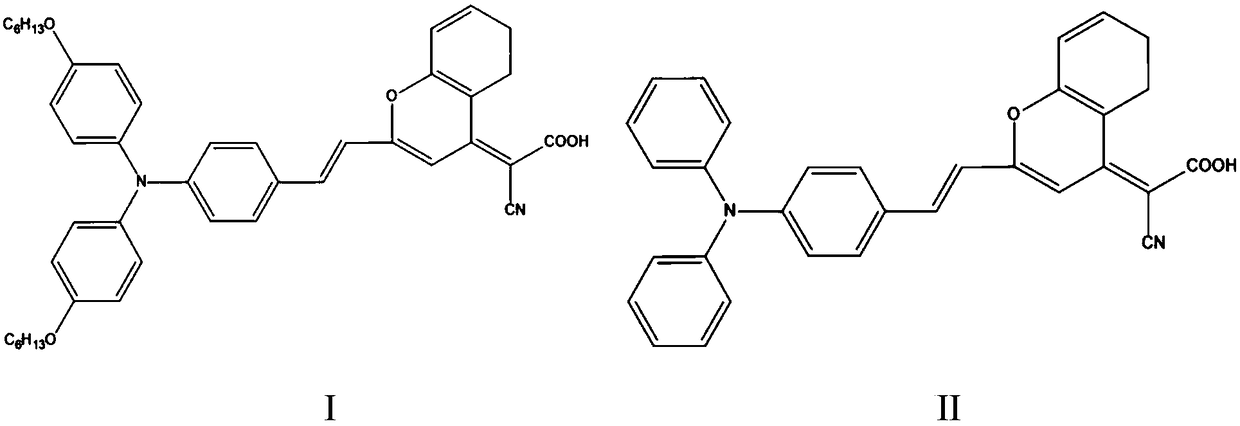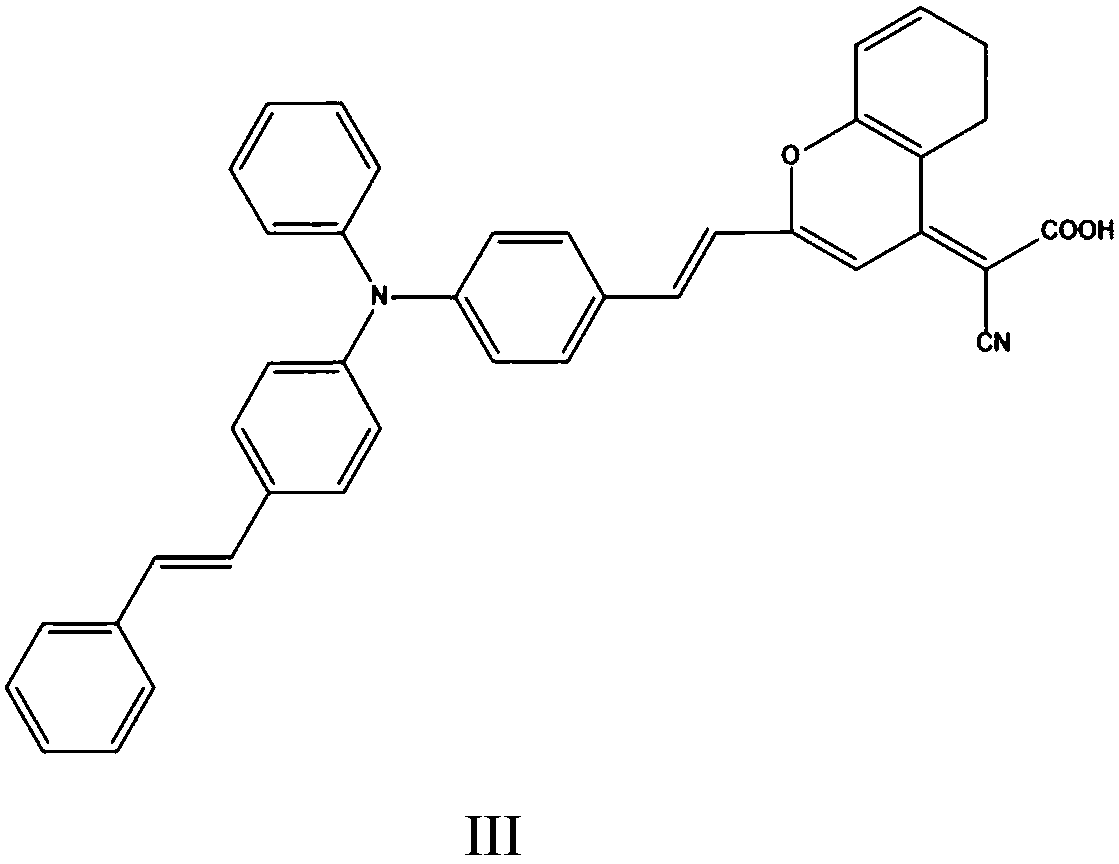Organic dye sensitized solar cell and preparation method thereof
A technology of solar cells and organic dyes, applied in the field of solar cells, can solve the problems of high cost and high price of solar cells
- Summary
- Abstract
- Description
- Claims
- Application Information
AI Technical Summary
Problems solved by technology
Method used
Image
Examples
Embodiment 1
[0046] The preparation of embodiment 1 organic dye-sensitized solar cell I
[0047] Step 1. Preparation of organic dye-sensitized photoanode: screen-print 20nm titanium dioxide colloid on clean FTO glass, put it in a muffle furnace for 15, 15 and 30 minutes at 150, 350 and 500°C respectively, and cool to After 70°C, a titanium dioxide layer that is well combined with FTO is obtained, and different layer thicknesses can be obtained by multiple printings; the photoanode is immersed in a concentration of 2.5×10 -4 mol / L organic dye solution with D-π-A structure, add chenodeoxycholic acid as a co-adsorbent, soak for 24 hours, take it out, wash it with absolute ethanol, and dry it with nitrogen;
[0048] The organic dye of the D-π-A type structure is obtained by the following method:
[0049] (1) Preparation of bis-hexyloxytriphenylamine: In a 100ml single-mouth bottle, add 4.4g (80mmol) potassium hydroxide, 40ml dimethyl sulfoxide, 4.4g (20mmol) p-iodophenol and 2.8ml (20mmol) )...
Embodiment 2
[0060] Embodiment 2 Preparation of organic dye-sensitized solar cell II
[0061] Step 1. Preparation of organic dye-sensitized photoanode: screen-print 20nm titanium dioxide colloid on clean FTO glass, put it in a muffle furnace for 15, 15 and 30 minutes at 150, 350 and 500°C respectively, and cool to After 70°C, a titanium dioxide layer that is well combined with FTO is obtained, and different layer thicknesses can be obtained by multiple printings; the photoanode is immersed in a concentration of 2.5×10 -4 mol / L organic dye solution with D-π-A structure, add chenodeoxycholic acid as a co-adsorbent, soak for 24 hours, take it out, wash it with absolute ethanol, and dry it with nitrogen;
[0062] The organic dye of the D-π-A type structure is obtained by the following method:
[0063] (1) Preparation of triphenylamine monoaldehyde: under ice-bath conditions, slowly add 1ml (11.2mmol) of phosphorus oxychloride dropwise to a reaction flask filled with 15ml (194.5mmol) of N,N-di...
Embodiment 3
[0074] Embodiment 3 Preparation of organic dye-sensitized solar cell III
[0075] Step 1. Preparation of organic dye-sensitized photoanode: screen-print 20nm titanium dioxide colloid on clean FTO glass, put it in a muffle furnace for 15, 15 and 30 minutes at 150, 350 and 500°C respectively, and cool to After 70°C, a titanium dioxide layer that is well combined with FTO is obtained, and different layer thicknesses can be obtained by multiple printings; the photoanode is immersed in a concentration of 2.5×10 -4 mol / L organic dye solution with D-π-A structure, add chenodeoxycholic acid as a co-adsorbent, soak for 24 hours, take it out, wash it with absolute ethanol, and dry it with nitrogen;
[0076] The organic dye of the D-π-A type structure is obtained by the following method:
[0077] (1) Preparation of styrene-substituted triphenylamine monoaldehyde: Weigh 4.3g (9.9mmol) benyltriphenylphosphine bromide and add it to a 100ml three-necked flask, then add 60ml of dry THF, cool...
PUM
| Property | Measurement | Unit |
|---|---|---|
| Thickness | aaaaa | aaaaa |
| Thickness | aaaaa | aaaaa |
Abstract
Description
Claims
Application Information
 Login to View More
Login to View More - R&D
- Intellectual Property
- Life Sciences
- Materials
- Tech Scout
- Unparalleled Data Quality
- Higher Quality Content
- 60% Fewer Hallucinations
Browse by: Latest US Patents, China's latest patents, Technical Efficacy Thesaurus, Application Domain, Technology Topic, Popular Technical Reports.
© 2025 PatSnap. All rights reserved.Legal|Privacy policy|Modern Slavery Act Transparency Statement|Sitemap|About US| Contact US: help@patsnap.com



